OLDSMOBILE SILHOUETTE 1997 Owners Manual
Manufacturer: OLDSMOBILE, Model Year: 1997, Model line: SILHOUETTE, Model: OLDSMOBILE SILHOUETTE 1997Pages: 436, PDF Size: 21.87 MB
Page 291 of 436
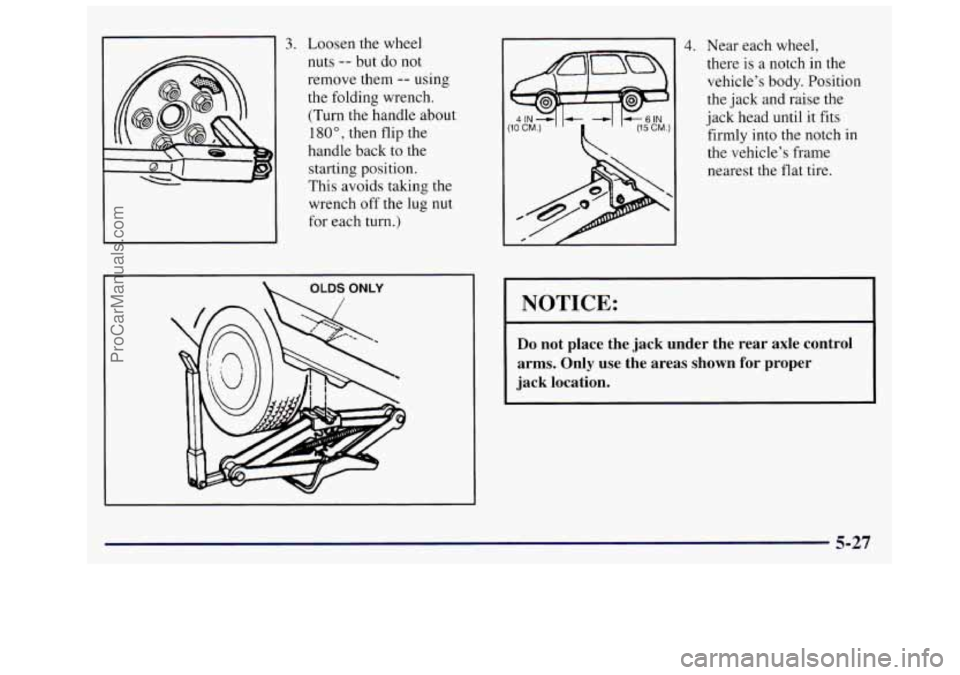
I 3. Loosen the wheel
nuts
-- but do not
remove them
-- using
the folding wrench.
(Turn the handle about
180", then flip the
handle back to the
starting position.
This avoids taking the
wrench
off the lug nut
for each turn.)
4. Near each wheel,
there is a notch in the
vehicle's
body. Position
the jack and raise the
jack head until it fits
firmly into the notch in
the vehicle's frame
nearest the flat tire.
NOTICE:
I
Do not place the jack under the rear axle control
arms. Only use the areas shown for proper
jack location.
ProCarManuals.com
Page 292 of 436
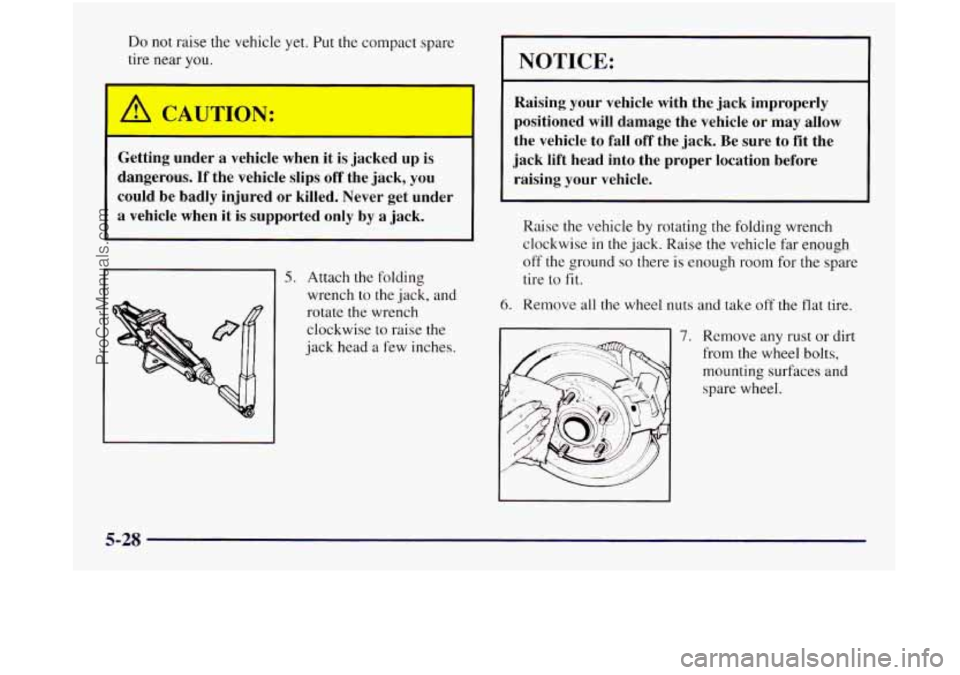
Do not raise the vehicle yet. Put the conlpact spare
tire near
you.
Getting under a vehicle when it is jacked up is
dangerous.
If the vehicle slips off the jack, you
could be badly injured or killed. Never get under
a vehicle when it
is supported only by a jack.
-1 5. Attach the folding
wrench to the jack, and
rotate
the wrench
clockwise to raise the
jack head
a few inches.
NOTICE:
Raising your vehicle with the jack improperly
positioned will damage the vehicle or may allow
the vehicle to fall off the jack. Be sure to fit the
jack lift head into the proper location before
raising your vehicle.
Raise the vehicle by rotating the folding wrench
clockwise
in the jack. Raise the vehicle far enough
off the ground
so there is enough room for the spare
tire to
fit.
6. Remove all the wheel nuts and take off the flat tire.
7. Remove any rust or dirt
from the wheel bolts,
mounting surfaces and
spare wheel.
5-28
ProCarManuals.com
Page 293 of 436
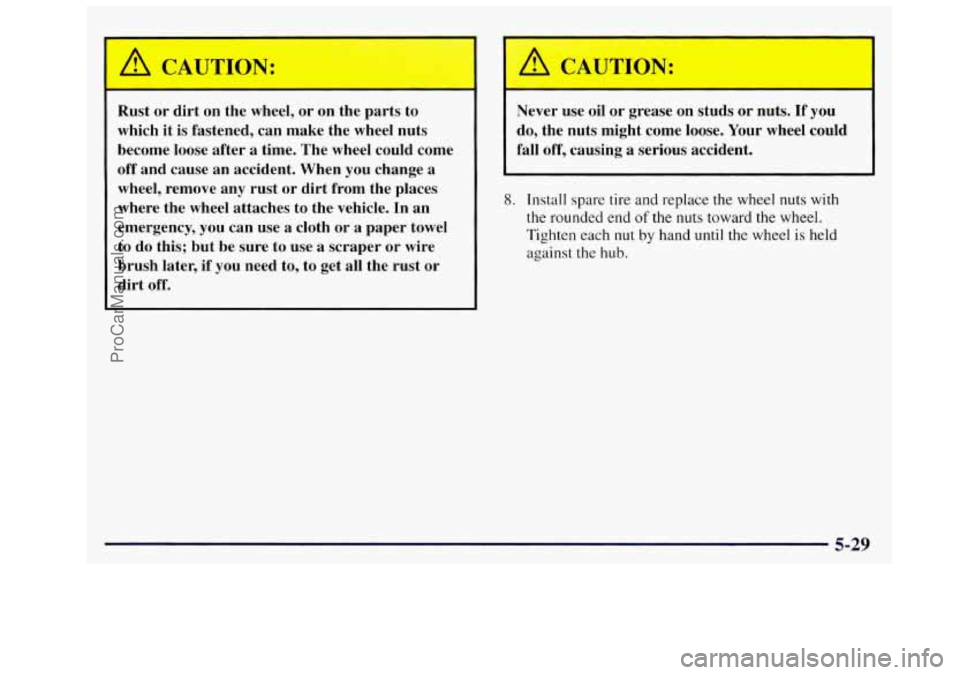
Rust or dirt on the wheel, or on the parts to
which it is fastened, can make the wheel nuts
become loose after a time. The wheel could come
off and cause an accident. When you change a
wheel, remove any rust or dirt from the places
where the wheel attaches to the vehicle. In an
emergency, you can use a cloth or
a paper towel
to do this; but be sure to use
a scraper or wire
brush later, if you need
to, to get all the rust or
dirt off.
A CAUTION: I
Never use oil or grease on studs or nuts. If you
do, the nuts might come loose. Your wheel could
fall off, causing
a serious accident.
8. Install spare tire and replace the wheel nuts with
the rounded end
of the nuts toward the wheel.
Tighten each
nut by hand until the wheel is held
against the hub.
5-29
ProCarManuals.com
Page 294 of 436
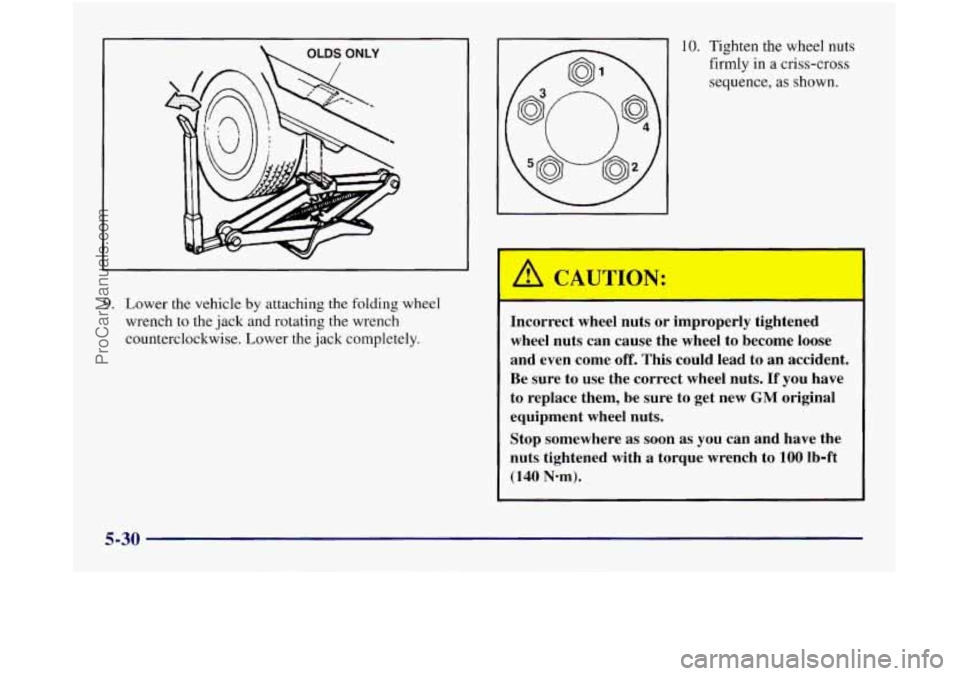
OLDS ONLY
9. Lower the vehicle by attaching the folding wheel
wrench to the jack and rotating the wrench
counterclockwise. Lower the
jack completely.
10. Tighten the wheel nuts
firmly in a criss-cross
sequence,
as shown.
IL IJ:
Incorrect wheel nuts or improperly tightened
wheel nuts can cause the wheel to become loose
and even come
off. This could lead to an accident.
Be sure to use the correct wheel nuts.
If you have
to replace them, be sure to get new GM original
equipment wheel nuts.
Stop somewhere
as soon as you can and have the
nuts tightened with a torque wrench to
100 Ib-ft
(140 N-m).
5-30
ProCarManuals.com
Page 295 of 436
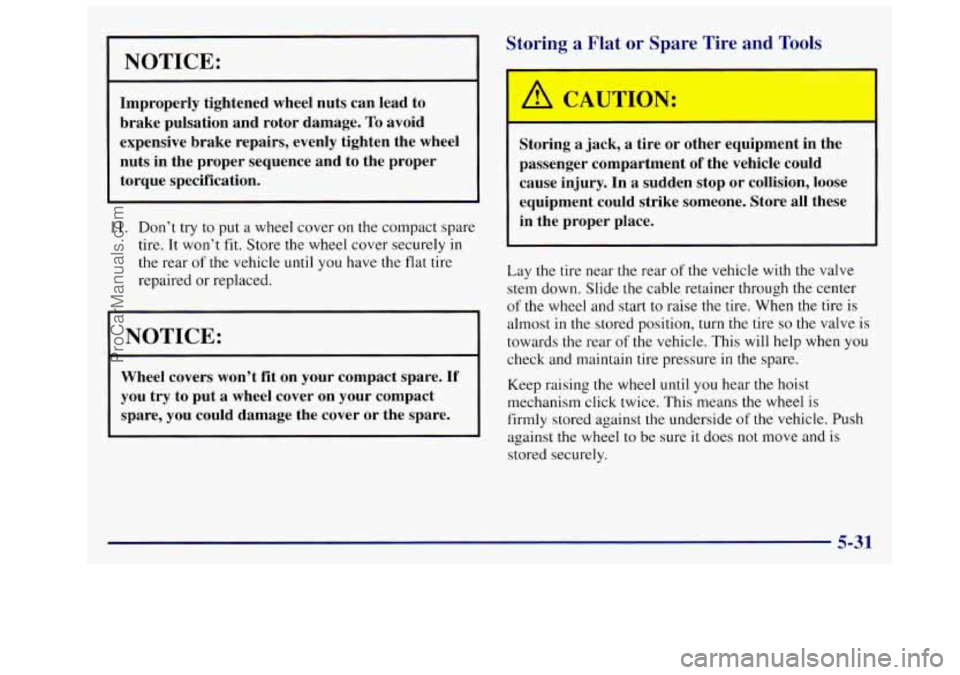
NOTICE:
Improperly tightened wheel nuts can lead to brake pulsation and rotor damage.
To avoid
expensive brake repairs, evenly tighten the wheel
nuts in the proper sequence and to the proper
torque specification.
11. Don’t try to put
a wheel cover on the compact spare
tire. It won’t fit. Store
the wheel cover securely in
the rear of the vehicle until you have the flat tire
repaired or replaced.
1 NOTICE:
Wheel covers won’t fit on your compact spare. If
you try to put a wheel cover on your compact
spare, you could damage the cover or the spare.
Storing a Flat or Spare Tire and Tools
Storing a jack, a tire or other equlpment in the
passenger compartment
of the vehicle could
cause injury. In
a sudden stop or collision, loose
equipment could strike someone. Store
all these
in the proper place.
Lay the tire near the rear of the vehicle with the valve
stem down. Slide the cable retainer through the center
of the wheel and start to raise the tire. When the tire is
almost in
the stored position, turn the tire so the valve is
towards the rear of the vehicle. This will help when you
check and maintain tire pressure
in the spare.
Keep raising the wheel
until you hear the hoist
mechanism click twice. This means the wheel is
firmly stored against the underside of the vehicle. Push
against the wheel to be sure it does
not move and is
stored securely.
ProCarManuals.com
Page 296 of 436
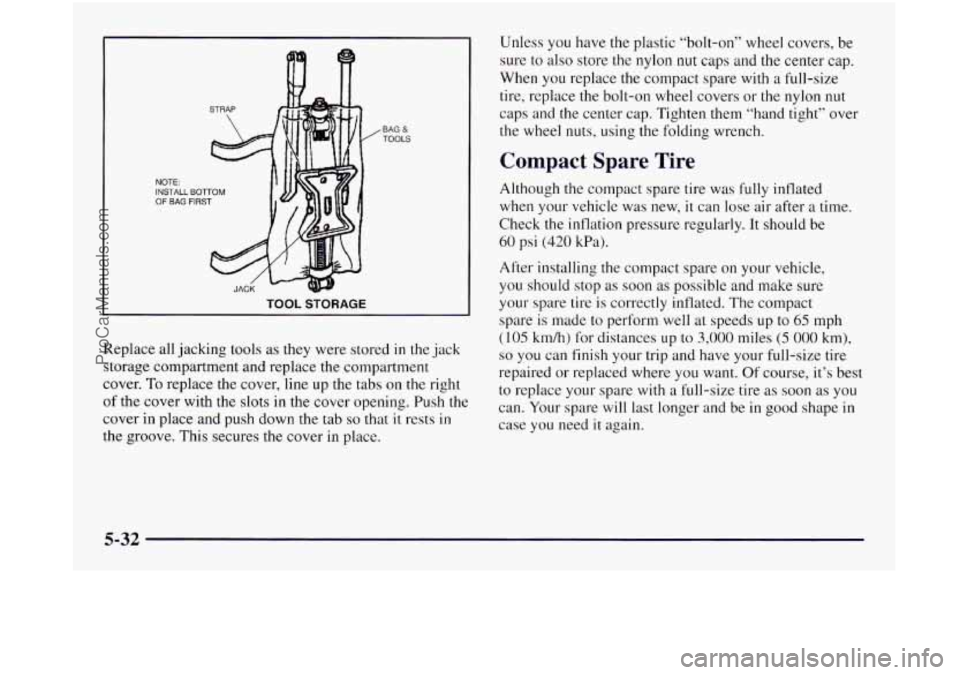
NOTE: INSTALL OF BAG - BOTTOM FIRST
TOOL STORAGE
BAG & TOOLS
Replace all jacking tools as they were stored in the jack
storage compartment and replace the compartment
cover.
To replace the cover, line up the tabs on the right
of the cover with
the slots in the cover opening. Push the
cover in place and push down the tab
so that it rests in
the groove. This secures the cover in place. Unless
you have
the plastic “bolt-on” wheel covers, be
sure to also store the nylon
nut caps and the center cap.
When
you replace the compact spare with a full-size
tire, replace the bolt-on wheel covers or
the nylon nut
caps and
the center cap. Tighten them “hand tight” over
the
wheel nuts, using the folding wrench.
Compact Spare Tire
Although the compact spare tire was fully inflated
when your vehicle was new, it can lose air after a time.
Check the inflation pressure regularly. It should be
60 psi (420
kPa).
After installing the compact spare on your vehicle,
you should stop
as soon as possible and make sure
your spare
tire is correctly inflated. The compact
spare is made to perform well at speeds up to
65 mph
(105 km/h) for distances
up to 3,000 miles (5 000 km),
so you can finish your trip and have your full-size tire
repaired or replaced where you want. Of course, it’s best
to replace your spare
with a full-size tire as soon as you
can. Your spare will last longer and be
in good shape in
case you need it again.
5-32
ProCarManuals.com
Page 297 of 436
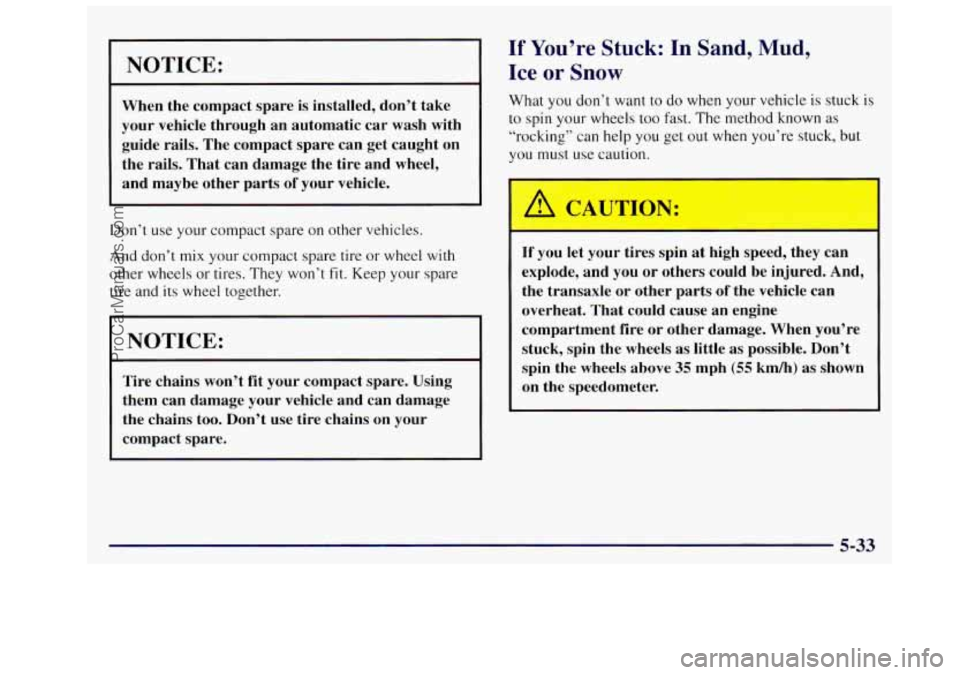
NOTICE:
When the compact spare is installed, don’t take
your vehicle through an automatic car wash with
guide rails. The compact spare can get caught on
the rails. That can damage the tire and wheel,
and maybe other parts
of your vehicle.
Don’t use your compact spare on other vehicles.
And don’t mix your compact spare
tire or wheel with
other wheels or tires. They won’t
fit. Keep your spare
tire and its wheel together.
NOTICE:
Tire chains won’t fit your compact spare. Using
them can damage your vehicle and can damage
the chains too. Don’t use tire chains
on your
compact spare.
If You’re Stuck: In Sand, Mud,
Ice
or Snow
What you don’t want to do when your vehicle is stuck is
to spin your wheels too fast. The method known as
“rocking’’ can help you get out when you’re stuck, but
you must use caution.
If you let your tires spin at high speed, they can
explode, and you or others could be injured. And,
the transaxle or other parts
of the vehicle can
overheat. That could cause an engine compartment fire or other damage. When you’re
stuck, spin the wheels as little as possible. Don’t
spin the wheels above
35 mph (55 km/h) as shown
on the speedometer.
5-33
ProCarManuals.com
Page 298 of 436
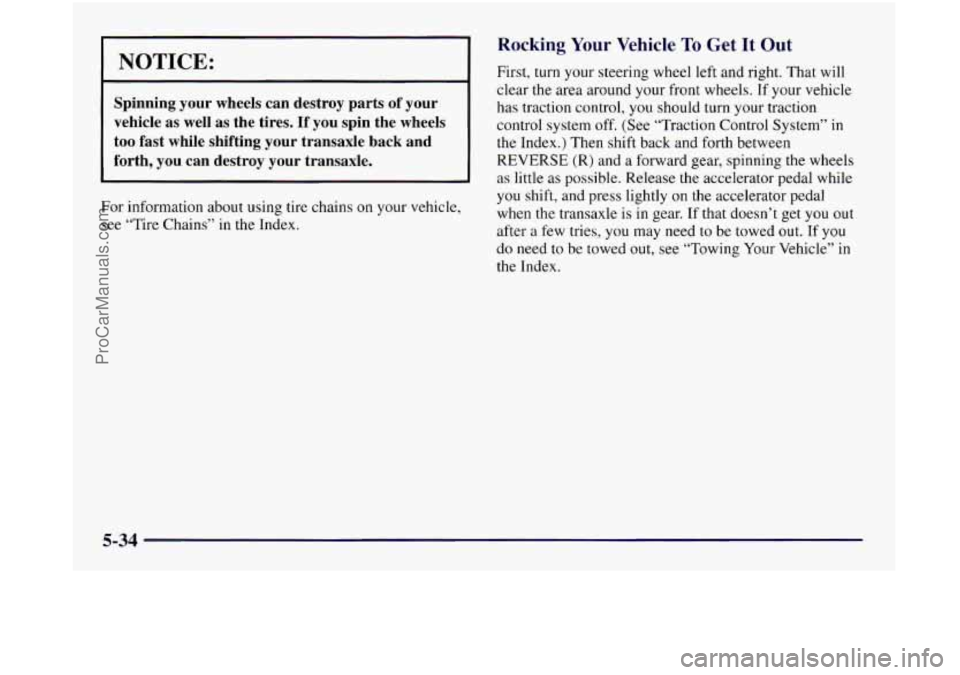
NOTICE:
Spinning your wheels can destroy parts of your
vehicle as well as the tires.
If you spin the wheels
too fast while shifting your transaxle back and
forth, you can destroy your transaxle.
For information about using tire chains on your vehicle,
see “Tire Chains” in the Index.
Rocking Your Vehicle To Get It Out
First, turn your steering wheel left and right. That will
clear the area around your front wheels. If your vehicle
has traction control, you should turn your traction
control system off. (See “Traction Control System”
in
the Index.) Then shift back and forth between
REVERSE
(R) and a forward gear, spinning the wheels
as little as possible. Release the accelerator pedal while
you shift, and press lightly on the accelerator pedal
when the transaxle
is in gear. If that doesn’t get you out
after a few tries, you may need to be towed out.
If you
do need to be towed out, see “Towing
Your Vehicle” in
the Index.
5-34
ProCarManuals.com
Page 299 of 436
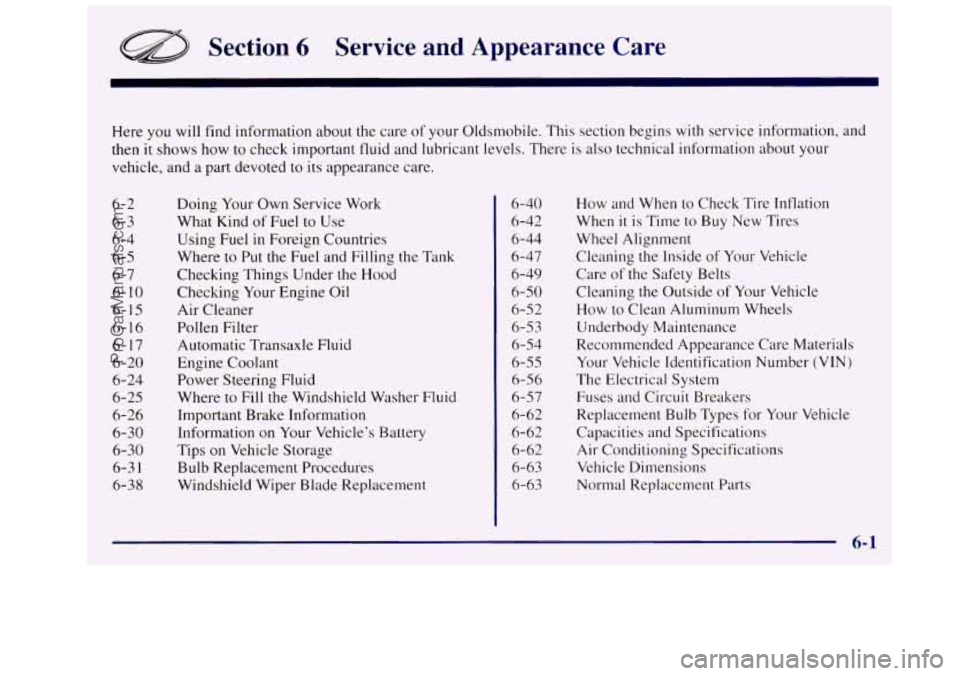
Section 6 Service and Appearance Care
Here you will find information about the care of your Oldsmobile. This section begins with service information, and
then it shows how to check important fluid and lubricant levels. There is also technical information about your
vehicle, and a part devoted
to its appearance care.
6-2
6- 3
6-4
6-5
6-7
6-10 6-15
6-16 6-17
6-20 6- 24
6-25
6-26
6-30 6-30
6-3
1
6-38 Doing
Your Own Service Work
What Kind
of Fuel to Use
Using Fuel in Foreign Countries
Where to Put the Fuel and Filling the Tank
Checking Things Under the Hood
Checking Your Engine
Oil
Air Cleaner
Pollen Filter
Automatic Transaxle Fluid
Engine Coolant
Power Steering Fluid
Where to Fill
the Windshielc 9 Washer Fluic
Important Brake Information
Information on Your Vehicle’s Battery
Tips on Vehicle Storage
Bulb Replacement Procedures
Windshield Wiper Blade Replacement 6-40
6-42
6-44
6-47 6-49
6-50
6-52
6-53 6-54
6-55 6-56
6-57
6-62
6-62
6-62 6-63
6-63 How and
When to Check Tire Inflation
When
it is Time to Buy New Tires
Wheel Alignment
Cleaning the Inside of Your Vehicle
Care of the Safety Belts
Cleaning
the Outside of Your Vehicle
How to Clean Aluminum Wheels
Underbody Maintenance
Recommended Appearance Care Materials
Your Vehicle Identification Number
(VIN)
The Electrical System
Fuses and Circuit Breakers
Replacement Bulb Types for Your Vehicle
Capacities and Specifications
Air Conditioning Specifications
Vehicle Dimensions
Normal Replacement Parts
6-1
ProCarManuals.com
Page 300 of 436
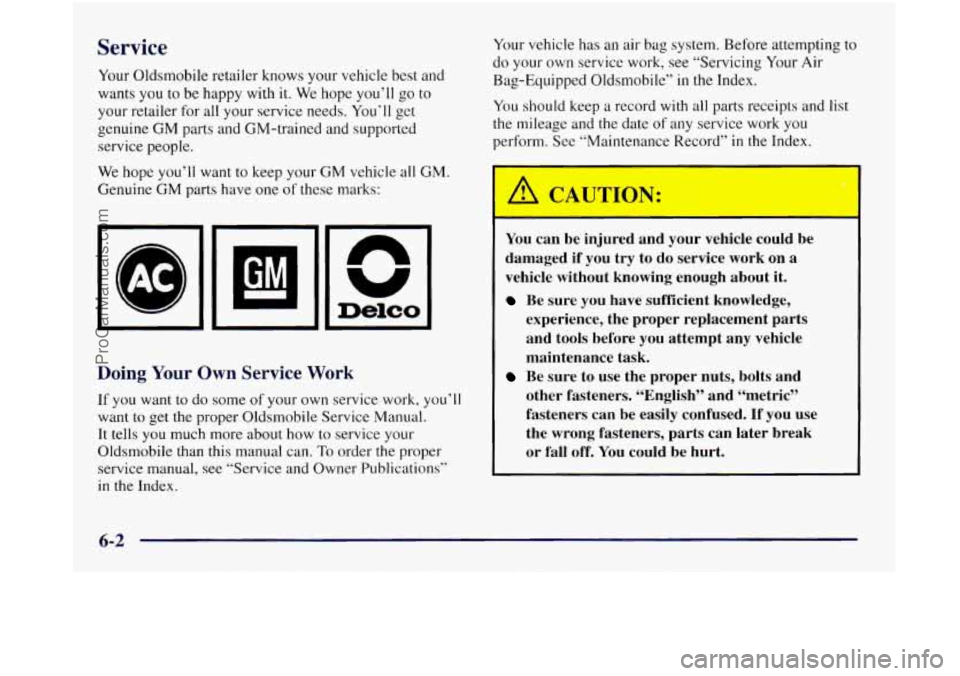
Service
Your Oldsmobile retailer knows your vehicle best and
wants you to be happy with it. We hope you’ll go to
your retailer for all your service needs. You’ll get
genuine
GM parts and GM-trained and supported
service people.
We hope you’ll want to keep your GM vehicle all GM.
Genuine
GM parts have one of these marks:
n
Delco
Doing Your Own Service Work
If you want to do some of your own service work, u’ll Y 0‘
want to get the proper Oldsmobile Service Manual.
It tells you much more about how
to service your
Oldsmobile than this manual can.
To order the proper
service manual, see “Service and Owner Publications”
in the Index.
.-
Your vehicle has an air bag system. Before attempting to
do your own service work, see “Servicing Your Air
Bag-Equipped Oldsmobile” in the Index.
You should keep a record with all parts receipts and list
the mileage and the date of any service work you
perform. See “Maintenance Record” in the Index.
You can be injured and your vehicle could be
damaged if you try
to do service work on a
vehicle without knowing enough about it.
Be sure you have sufficient knowledge,
experience, the proper replacement parts
and tools before you attempt any vehicle
maintenance task.
Be sure to use the proper nuts, bolts and
other fasteners. “English” and “metric”
fasteners can be easily confused. If you use
the wrong fasteners, parts can later break
or fall off.
You could be hurt.
6-2
ProCarManuals.com